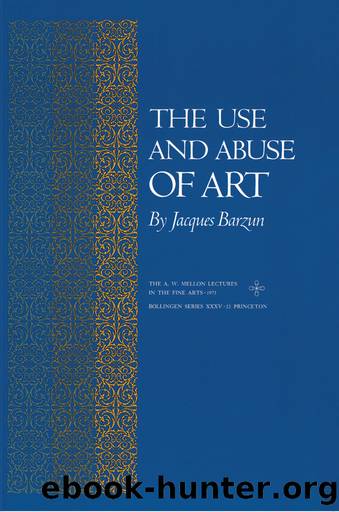The Use and Abuse of Art by Jacques Barzun

Author:Jacques Barzun
Language: eng
Format: epub
Publisher: Princeton University Press
Published: 2020-12-15T00:00:00+00:00
The competition of drugs, sex, and yogi exercises suggests that chemical or physical action is being thought more reliable.
In its present incarnations art is further weakened by excess. We continue to absorb it in the old way, naming the artist, trying to remember the title and appearance of his works. But more and more these blur into the semblance of interchangeable parts. It is often an accident of time (or the result of a planned outrage) when an item otherwise indistinguishable from the mass achieves particularity. And even then, it is as a label in the memory rather than as a source of energy to which we return of set purpose, grateful and overawed. It is reasonable to suppose that the type of shock by brutality that has become usual interferes with the deeper, less obvious shock that used to make works of art seem to convey religious tidings.
The confusion by violence and by numbers has another consequence. Whatever the upshot of these assaults on our sensibilities, we are not redeemed together. It is not solely that we lack the communicative warmth that arises from the varieties of a single style agitating many minds; it is that we are thrown back too exclusively on our own resources. âSee what you make of it!â says the canvas or poem. âUnchain your unconscious and ârelateâ â says the theater of the absurd and the obscene. The relation is unspecified. The depths that are stirred, if any, vary in density. Even momentary gratification is a matter of luck. We would expect a religion to do better and channel the expected flow of lava. The works of nineteenth-century art that are now considered too great, too pompous and heaven-storming, at least prevented the onlookerâs imagination from straying away in self-indulgence. And they did create around themselves a body of lovers linked together quasi-religiously; whereas the gayer, more modestly democratic and âdisposableâ works of today, content to give a nudge and leave the rest to us, succeed only in arousing what they cannot satisfy.
To this verdict there is of course the exception of revolutionary art. Its doctrine can be reactionary, theological, or anarchist: message is the unifier and director of destinies. Whoever is moved by such art knows what fulfillment to look for not merely in the next artistic experience but in human life as well.
Unfortunately revolutionary art tends to be strong in message and weak in art. All the great revolutions since 1789 have given art encouragement, but evidently not of the right kind or not to the right artists. Propaganda art has proved ineffectual as art, and the exceptions have confirmed the rule by being ineffectual as propaganda, the message being lost in the excitement of the art. Has anyone ever turned Calvinist from even the most enthralled reading of Paradise Lost? Who thinks of Tolstoyâs theory of history when remembering War and Peace? We are back at lesson one about the nature of art, which is that its contents defy literal expression.
Download
This site does not store any files on its server. We only index and link to content provided by other sites. Please contact the content providers to delete copyright contents if any and email us, we'll remove relevant links or contents immediately.
The Japanese by Christopher Harding(1085)
Watercolor With Me in the Forest by Dana Fox(753)
A Theory of Narrative Drawing by Simon Grennan(742)
The Story of the Scrolls by The Story of the Scrolls; the M(725)
Glittering Images: A Journey Through Art From Egypt to Star Wars by Camille Paglia(717)
Boris Johnson by Tom Bower(620)
This Is Modern Art by Kevin Coval(597)
The Art and Science of Drawing by Brent Eviston(588)
Frida Kahlo by Frida Kahlo & Hayden Herrera(584)
AP Art History by John B. Nici(574)
Banksy by Will Ellsworth-Jones(569)
War Paint by Woodhead Lindy(551)
Van Gogh by Gregory White Smith(547)
Draw More Furries by Jared Hodges(544)
About Looking by John Berger(543)
Scenes From a Revolution by Mark Harris(542)
Ecstasy by Eisner.;(535)
100 Greatest Country Artists by Hal Leonard Corp(523)
Young Rembrandt: A Biography by Onno Blom(512)
